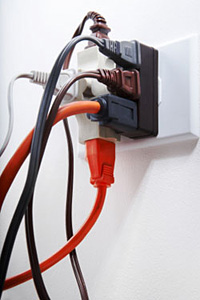 |
 |
 |
 News from Around Banderas Bay | October 2007 News from Around Banderas Bay | October 2007  
What Your Home Wants You To Know - Residential Electrical 101
 Jim Morrison - PVNN Jim Morrison - PVNN


| | Never overload extension cords or wall sockets |
Electricity can be difficult to understand, and a whole lot of people don’t understand it as well as they think they do. I hear a lot of expats remark with surprise at how many ungrounded two slot electrical receptacles there are down here and resolve immediately to have a grounded circuit installed for their computers to protect them. But protect them from what exactly?

Grounding
Grounding is important, but not for the reasons most people think. In fact, in the US, it has only been required to ground electrical receptacles since 1962. Grounding your residential electrical system helps to limit voltage potential between the system and the earth, so in the event of a lightning strike, or other major line surge (such as a car hitting the telephone pole outside your house or the utility company opening and closing circuits), your house doesn’t go up in smoke. Grounding protects your house, and is just as important whether the power is on or off. Grounding a single circuit in a house is hardly worth the effort.

Grounding begins at the transformer, where the neutral (or grounded conductor) is connected to the earth. The neutral then travels to the house and is grounded again where it connects to the service panel. Newer electrical circuits also contain bare copper ground wires that connect back to that point. Since the wiring in your home is essentially a lightning antenna, the grounding system simply gives it a path to the soil. That’s all. Under normal circumstances, your computer will work just fine whether it’s plugged into a grounded receptacle or not.

If you really want to protect your sensitive electronics from power surges, have an electrician install a high quality surge suppressor in the main panel, and make sure your grounding system is intact and adequately sized. Then, you should plug your appliances into an uninterruptible power supply and a high quality surge suppressor. If the outlet is grounded, so much the better! Most important of all, don’t rest drinks near your laptop. My guess is root beer has damaged more computers than lightning has...

Voltage Drop
If you really want to protect your sensitive electronic equipment, you should probably be more concerned about something you may never have heard of, voltage drop. When current passes through a wire, it naturally meets some resistance, resulting in a small amount of lost voltage. This loss is called voltage drop.

Appliances draw a certain number of watts when they operate. Watts = Amps X Volts. When voltage drops, appliances draw more amps to compensate. The US National Electrical Code (which was adopted by Mexico as well) says that voltage drop should be kept below 5%, which is a bit unrealistic. Most electronic equipment is designed to run just fine with voltage drops between 5-10%. I’ve found voltage drops of around 10% in most of the homes I’ve inspected. In my opinion, voltage drop probably isn’t going to impact the vast majority of appliances until it gets to be 15-20% or higher.

How Do You Fix It?
Voltage drop is a function of the resistance caused by excessively long cable runs and multiple and/or bad splices. To fix it an electrician should:

• Calculate the cable runs to the affected receptacles to determine if the cables are properly sized and replace them if they aren’t.

• Investigate the integrity of the splices at the outlets, improving them as necessary. Especially if the receptacles are back-fed. These are notoriously high resistance, poor connections.

Reversed Polarity
This is another very common defect we find in older as well as newer construction. In most receptacles, one of the vertical slots is a little shorter than the other. The shorter one should be “hot” and the longer one should be “neutral.” When the outlet is wired incorrectly so that the longer slot is “hot,” we call this reversed polarity.

Most appliances will operate just fine when plugged into a receptacle with reversed polarity, but it can be dangerous in certain circumstances. Since the solution (removing the receptacle and properly installing it) is simple and fast, we always recommend that they be fixed right away.
 Casas del Mar is a property services firm that manages, rents, and inspects homes all over the Banderas Bay area. Their philosophy is simple: "Listen to your customers, and don’t quit until they are happy. Ever." You can send them your questions at info@CasasDelMarPV.com. They are your real estate resource. Casas del Mar is a property services firm that manages, rents, and inspects homes all over the Banderas Bay area. Their philosophy is simple: "Listen to your customers, and don’t quit until they are happy. Ever." You can send them your questions at info@CasasDelMarPV.com. They are your real estate resource.

Click HERE for more articles by Jim Morrison. | 
 | |
 |



